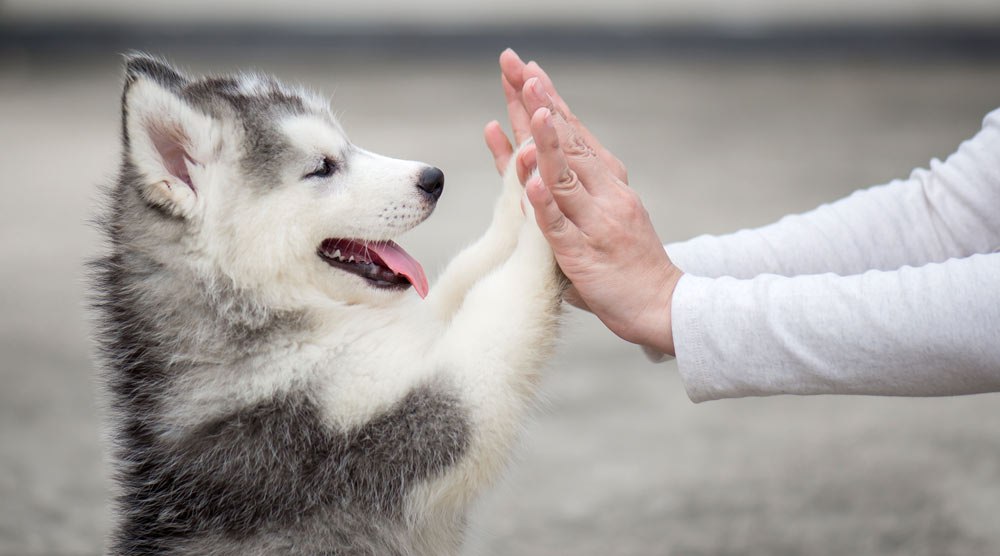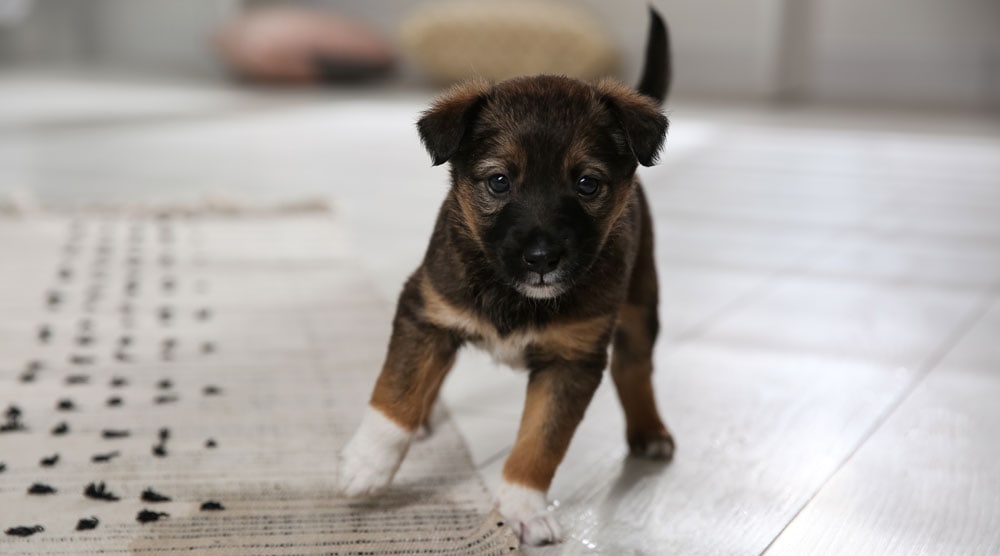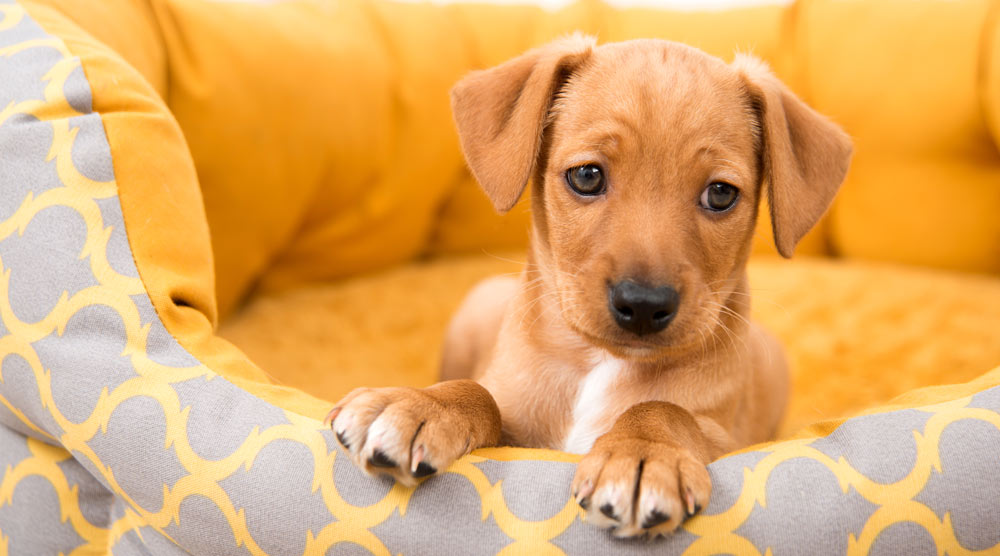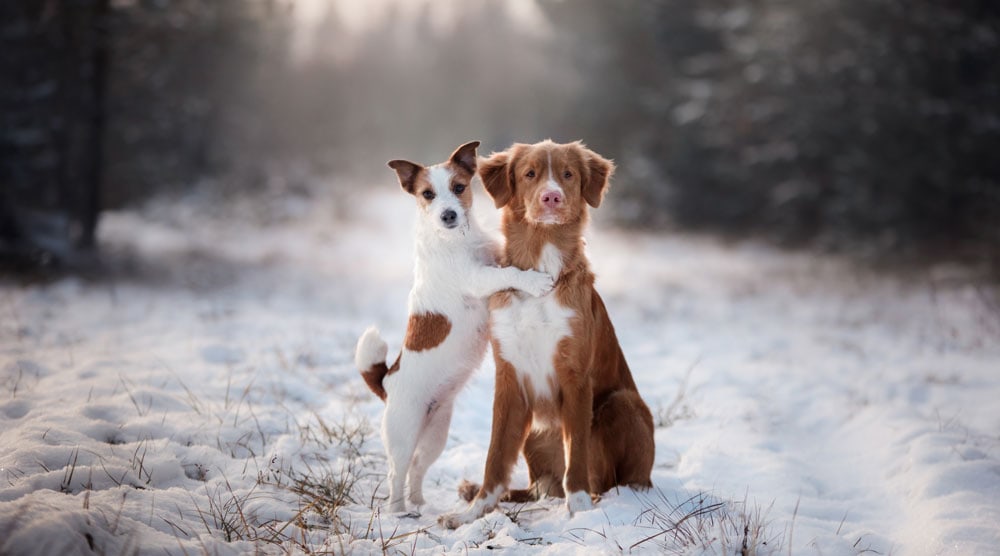Developing a strong bond with your puppy helps them settle in and gain confidence. They’ll also be more receptive to training. Read on for tips on how to bond with your puppy.
Contents
- 1. Spend Lots of Positive Bonding Time With Your Puppy
- 2. Always Be Patient With Your Puppy (Especially With Toilet Training!)
- 3. Puppy Play Time is Essential
- 4. Only Use Positive Reinforcement Training (No Punishment)
- 5. Teach Your Pup Basic Cues (Sit, Stay, Down)
- 6. Learn to Recognise Signs of Stress and Anxiety in Your Puppy
- 7. Respect Your Dog’s Need for Space and Quiet
- 8. Take Your Puppy on Short Walks
- 9. Be Consistent And Develop a Routine for a Quicker Bond
- 10. Show Your Puppy Love, Respect and Affection
- How Long Does It Take to Bond With a Puppy?
- How to Bond With Your Puppy Summary
After all, they’ve been thrust into alien surroundings with unfamiliar sights, sounds, and smells. They’ve also been separated from their mom and littermates.
For these reasons, helping your dog to forge strong bonds with their new family is vital. A bond of trust makes puppies feel more confident and reduces stress. It also helps the dog cope with new experiences and environments, while providing the foundation for training.
Studies have even shown that dogs who have a ‘secure base’ in their humans are more relaxed and better able to play, interact, and problem-solve.
The good news is that puppies tend to form bonds surprisingly quickly. Here are some tips to nurture the bonding process.
1. Spend Lots of Positive Bonding Time With Your Puppy
The biggest factor when forming a strong bond with your puppy is to be present and make time for them.
You want to have lots of fun and affectionate interactions each day, so your new dog is constantly learning that good things happen when you’re around. The more time you spend with your puppy, the faster a strong bond will form.
These bonding interactions don’t need to be complicated. Simply enjoying quiet time together, like snuggling on the sofa in front of the TV, is a great example*. Walks, reward-based training sessions, and simple games will also strengthen your bond and build trust.
* Not all dogs like snuggling up on the sofa, as it makes them feel trapped. Let your puppy settle wherever he feels most comfortable.

Practice Alone Time Too
Although you shouldn’t leave your puppy alone for long periods, it’s also important to teach him to feel comfortable spending time without you nearby.
The solution is to slowly build up positive associations with “alone time.” You want your puppy to associate being alone with fun things, so give him a puppy chew toy, Kong stuffed with treats, or a simple puzzle toy to distract him when you’re gone.
Make sure you introduce alone time gradually. If your puppy is suddenly left for a couple of hours, they could become stressed, and it will be more difficult for them to adjust to being left in the future.
In fact, it’s a good idea to start with your dog behind a baby gate, where he can still see you. Over time, you can progress to being in a different room, and eventually short periods out of the house. Remember not to make a fuss when you return – the practice sessions should always be calm.
We don’t recommend getting a dog if you work full-time and there is no-one else in the house though. Dogs thrive on human company, so it’s unfair to leave them for long periods at any age.
Note: If your puppy becomes destructive, continuously barks, or is unable to settle when alone, he may be suffering from separation anxiety. This is a serious behavioral issue that should always be discussed with a qualified dog behaviorist.
2. Always Be Patient With Your Puppy (Especially With Toilet Training!)
Puppies aren’t born knowing how to behave in a human world. They don’t instinctively understand that toileting on the carpet is bad, or that slippers aren’t a soft chew toy. You’ll need to teach your pup which behaviors are appropriate – and this can take time.
Although you may feel exasperated if they pee all over your favorite rug (again), shouting will only damage your bond (see point #4 below.) Your puppy won’t associate the shouting with what they’ve done, and it doesn’t teach them the “right” behavior.
Instead, take the time to regularly go into the garden and give them the opportunity to potty outside. Don’t be in a rush, be patient, be consistent, and, when they do toilet outside, make sure you’re armed with lots of yummy treats and shower them with praise. The bonding process will be much smoother if you’re always kind and patient.
3. Puppy Play Time is Essential
The importance of play for puppies can’t be overstated. Games and toys provide an opportunity to work on training, build confidence, increase physical fitness, and reduce stress levels. Selecting the right type of play for your pup can also provide an appropriate outlet for instinctual drives, such as chewing or ragging.
Most importantly for this article, playing with your dog is one of the best ways to strengthen your bond.
You might need to experiment during the bonding process to find out what play your puppy enjoys the most. Breeds with strong hunting drives, for example, may enjoy squeaky toys and scent work games. If you have a herding breed pup, they might prefer playing fetch or hide and seek.
Check out our list of 24 fun indoor activities if you’re looking for inspiration when bonding with your puppy.
4. Only Use Positive Reinforcement Training (No Punishment)
Punishing a puppy isn’t just cruel, it’s also unnecessary and even counter-productive. Gentler, force-free training methods have proven to be more effective, plus they strengthen your bond, rather than damage it.
Scolding your dog, using harsh tones, or practicing other aversive techniques, makes your puppy scared to be near you. They’ll lose trust in you and may start to shut down. Negative techniques can also cause unwanted reactions, such as defensive behavior.
Aversive training methods also don’t teach your dog the desirable behavior. If you shout at your puppy in a harsh tone when he barks at the postman, for example, he only knows that you’re angry – not what you want him to do instead. The outcome is increased stress associated with the postman arriving (because he gets shouted at without understanding why), without teaching an alternative behavior.
The solution is to use a combination of management techniques and positive reinforcement training.
Management involves eliminating the opportunity for your dog to perform unwanted behaviors. This is called “setting your dog up for success,” as they don’t get a chance to develop bad habits in the first place.
For example, you might install baby gates to prevent your dog having access to slippers or shoes when you’re not watching. Blocking windows so your puppy doesn’t bark at birds and using a playpen when you can’t supervise are two other common examples.
Once you’ve minimised the chance of problem behaviors, you can then use positive reinforcement to teach the puppy what you want from them.
The basic principles of positive reinforcement dog training are to ignore the undesired behavior and reward what you’re looking for instead. Timing and consistency are key, as you want your dog to link the reward with the “right” behavior.
Let’s use jumping up as an example, as this is a common puppy problem. Constantly pushing the puppy off and scolding them can actually be reinforcing for the dog, and, crucially, it doesn’t teach them what to do instead. It can also harm the budding bond with your new puppy.
Instead, ignore your pup completely when they’re jumping up and then reward them the moment all four paws are on the floor. If you apply this consistently, your puppy will learn that they only get attention when they’re calm.
5. Teach Your Pup Basic Cues (Sit, Stay, Down)
Basic cues like sit, stay and down are useful for everyday life. They can also be a straightforward way to start your training journey and build a strong connection.
You can start teaching simple cues as soon as your puppy is settled in. Keep training sessions short and fun, as puppies get tired quickly, and make sure you have plenty of high-value food or toy rewards.
Timing is everything when using positive dog training methods. If you’re practising a sit, you need to reward your puppy the moment their butt hits the floor. Even a short delay can be confusing for the puppy, or even cause them to associate the treat with another behavior.
Start in a low-distraction environment, and make sure your dog has nailed a cue before practicing outside in the garden or at a park. Try to end each mini-session on a high note. Be patient with your pup and don’t take things too fast – the goal is for your dog to have fun, as this is vital for the bonding process.
6. Learn to Recognise Signs of Stress and Anxiety in Your Puppy
It’s vital to recognise when your dog is stressed or anxious. You can then remove stress triggers, avoid situations that make them uncomfortable, and practice desensitization training. Over time, this helps your puppy to feel secure and also teaches them to trust you.
Unfortunately, canine body language isn’t always intuitive. There are lots of subtle signs your puppy isn’t comfortable that are often easy to miss. Even tail wagging, the most well-known canine body language signal, doesn’t always mean your dog is happy.
Some things to look for in an anxious dog include a tucked tail, excessive panting, trying to hide, lip licking, tense or hunched posture, yawning, sniffing and shaking. You may also notice that your dog looks away from people or objects that he’s worried about.
When you notice signs of stress in your dog, try to identify what’s causing it. Are there children playing close to his bed? Is he scared of the new lamp you just bought? Did someone give him a hug and make him feel trapped? Or are there unusual sounds? Once you identify the trigger, remove the puppy (or trigger) from the situation to relieve the stress. At a later date, you can work on desensitization and counterconditioning by using the same trigger at a lower intensity.
Tip: Try to remain relaxed yourself too. Studies have shown that dogs can pick up on our anxiety levels, and it can make them feel more on edge. A stressful household may also make bonding with your pup more difficult.
7. Respect Your Dog’s Need for Space and Quiet
Although it’s important to spend time with your puppy, you should also give them space to sleep, relax, and unwind. All dogs need time to themselves, and providing a safe space can reduce stress and increase confidence.
A crate can be a good option – providing it’s introduced positively. A play pen or comfortable bed can also work for a new puppy. The key is to ensure that your dog is never disturbed when he goes there. Ideally, this space should be in a quiet room, to give your puppy the chance to decompress away from a noisy environment.
If you have children, they’ll need to learn to be respectful of this space and not to bother the new puppy. Never allow children to wake the puppy, chase him, or pester him in his crate, bed or other safe space. Aside from being unfair on the dog, this can cause him to become stressed or even defensive.
Tip: For a full list of items you’ll need for a puppy, download our puppy gear checklist.
8. Take Your Puppy on Short Walks
Once your new puppy has been vaccinated, introducing short walks is important for exercise and mental stimulation. It’ll also strengthen your bond further, as your dog will associate you with going on fun and enriching adventures.
Make sure every part of the walking experience is a positive one for your pup. Right from the start, you should carefully introduce them to a leash and harness. Also, ensure that any socialization they have with people or dogs outside is controlled and calm.
9. Be Consistent And Develop a Routine for a Quicker Bond
It’s all too easy to become complacent due to your puppy’s cuteness. When they’re little and jump up for cuddles, it seems endearing rather than a potential problem. Flash forward a few months to when the rapidly growing dog is jumping up and scratching your kid’s arms, or bowling over your elderly neighbor, and it isn’t quite so cute.
Consistency is the key, and you need to start as you mean to go on. It can be confusing for your dog if they’re suddenly no longer allowed on the bed or the sofa, or on your lap in the car (which isn’t a good idea from a safety perspective anyway). This confusion can lead to a breakdown in the bond you’re building.
Additionally, make sure that everyone in the household provides consistent rules and boundaries. You should also teach other family members how to reinforce good behavior and ignore unwanted ones.
Sticking with a routine can also make your puppy feel more secure and relaxed. Over time, if the dog learns when he’s likely to be fed, exercised, taken on toilet breaks, and played with, it’s easier for him to settle into the home.
10. Show Your Puppy Love, Respect and Affection
Ultimately, the more love and respect you give your new puppy, the stronger your bond will become.
If you teach your pup that you’re a consistent, reliable, fun, and kind part of their life, your connection will inevitably be deeper.
Even just making sure your dog’s basic needs are met can increase your bond of trust. Thinking about the Five Freedoms / Provisions of Animal Welfare can focus your priorities. On the surface, they might seem rather obvious, but it’s a good place to start.
Your dog should always have access to good nutrition and a suitable environment, be in good health, and have the opportunity to engage in appropriate behaviour with positive mental experiences.

How Long Does It Take to Bond With a Puppy?
Just like human bonding, building a strong bond with your puppy isn’t going to happen overnight. Puppies usually form attachments with their owners quicker than older dogs. The timescale will vary, though, depending on a whole variety of factors.
The puppy’s experiences in the first few weeks of their life can have a big impact. This is part of the reason why selecting a reputable breeder is vital. Dogs from backyard breeders or puppy mills won’t have had appropriate socialization and may even have been mistreated. The puppy’s individual personality and your home environment will all play a role in building a bond too.
Give a puppy time, be patient, and allow them time to settle. The Rule of 3 that is often applied for adopted dogs is a useful point of reference. It gives you an idea of how your dog could be settling into their life at the three days, three weeks, and three months stages.
Don’t be frustrated if your puppy doesn’t instantly form a bond with you, or if they initially latch onto one particular member of the family. Over time, your puppy will develop relationships with everyone in the household who treats them with love and respect.
How to Bond With Your Puppy Summary
Building a bond is a priority when adopting a new puppy. It’ll boost their confidence, reduce stress levels, and increase your success with training.
The most important thing is to treat your dog with love and respect. Using positive training techniques, giving your new puppy space when they need it, and allowing them the opportunity to be involved in fun and enriching activities can also help to build a strong and trusting relationship.
Do you have any questions about how to bond with a new puppy? Please leave a comment below. You may also want to read our guide to the first week of caring for a new puppy.




